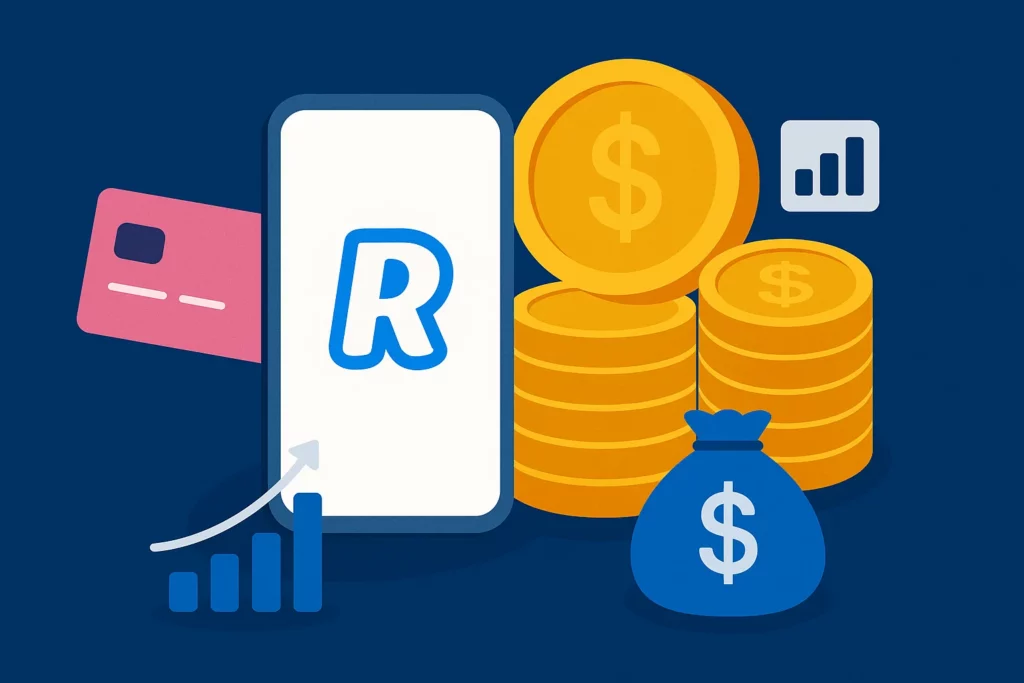In a world where digital finance is rapidly replacing traditional banking, Revolut has emerged as a fintech powerhouse. Launched in 2015 as a low-fee currency exchange app, Revolut has evolved into a full-fledged neobank, offering services ranging from banking and crypto trading to travel insurance and stock investments — all packed into a slick mobile interface.
Today, with 40M+ users globally and a valuation surpassing $33 billion, Revolut isn’t just disrupting banking — it’s redefining how people manage money. But how does this digital bank-without-branches actually make money? And more importantly, can startups and SaaS founders replicate Revolut’s highly diversified revenue strategy?
In this blog, we’ll unpack the revenue model of Revolut, analyze its top income sources, and explore how entrepreneurs can launch their own Revolut-like app with a similar monetization strategy using Miracuves Revolut clone solution.

How Revolut Makes Money in 2025
Revolut’s revenue model is built around diversification and scalability. It doesn’t rely on one primary income source but instead monetizes across multiple channels — from retail users to businesses. Here’s a snapshot of how Revolut earns its revenue:
- Subscription Plans: Paid tiers like Plus, Premium, and Metal offer enhanced banking services.
- Interchange Fees: Earned from merchant fees whenever users spend with their Revolut cards.
- Currency Exchange Margins: Small markups on FX transactions during weekdays and larger ones on weekends.
- Crypto & Stock Trading Fees: Charges for trading cryptocurrencies and fractional shares.
- Business Accounts: Monthly fees and payment processing revenue from Revolut Business users.
- Lending Products: Interest from personal loans, payday advances, and credit products.
- Travel & Lifestyle Products: Revenue from insurance bundles, travel bookings, and airport lounge access.
- Partner Offers & Cashback: Affiliate earnings and commissions from in-app promotions.
With such a wide net, Revolut monetizes almost every interaction a user has with money — making it one of the most efficient digital banking revenue engines in the world.
Detailed Breakdown of Revenue Channels
Let’s examine each of Revolut’s income streams and how they work, who pays for them, and why they scale so effectively in the fintech ecosystem.
1. Subscription Plans (Plus, Premium, Metal)
How it works:
Revolut offers tiered monthly plans priced at around €2.99, €7.99, and €13.99, respectively. Each plan unlocks additional features like higher ATM withdrawal limits, travel insurance, priority support, virtual cards, and exclusive cashback deals.
Who pays:
Retail users looking for extra value and convenience.
Why it scales:
Recurring revenue from subscriptions ensures predictable income. Revolut reported 40% of its revenue from subscriptions in some markets, proving strong product-market fit.
2. Interchange Fees
How it works:
Every time a user spends using their Revolut card, Revolut receives a small percentage (~0.2–1.5%) from the merchant as an interchange fee.
Who pays:
Merchants, via their payment processors.
Why it scales:
With billions in card transactions processed annually, even a small fee adds up to a major revenue stream — and it grows with user activity.
3. Currency Exchange Margins
How it works:
Revolut allows foreign currency conversion with mid-market rates, but applies small markups outside of working hours or beyond fair-use limits.
Who pays:
Users exchanging money over free-tier limits or on weekends.
Why it scales:
With users in over 200 countries, Revolut handles over $1.5B in daily FX volume, making this a key profit center.
4. Crypto & Stock Trading Fees
How it works:
Users can buy, sell, or hold cryptocurrencies and stocks. Revolut charges a markup on each transaction (e.g., 1.5% for crypto trades) and earns FX fees for international stock purchases.
Who pays:
Retail users and crypto enthusiasts.
Why it scales:
Fintech is merging with retail investing. With over 25M crypto users and integrated trading features, Revolut monetizes high-frequency, high-margin behavior.
5. Revolut Business Accounts
How it works:
Businesses pay a monthly fee for access to multi-currency accounts, team cards, invoicing, API integrations, and international transfers.
Who pays:
Startups, freelancers, and enterprises.
Why it scales:
B2B SaaS-like pricing ensures higher lifetime value (LTV). Revolut Business contributes over $100M/year to its top line.
6. Lending & Credit Products
How it works:
Revolut offers instant credit lines, personal loans, and even “payday advance” features. It earns interest and processing fees.
Who pays:
Borrowers and users opting for flexible credit.
Why it scales:
With proprietary risk modeling and data, Revolut has the infrastructure to scale lending profitably without relying on traditional banks.
7. Travel, Insurance & Lifestyle Products
How it works:
Bundled services like travel insurance, airport lounge access, hotel booking perks, and medical coverage are monetized via markups or affiliate models.
Who pays:
Premium-tier users and travelers.
Why it scales:
Lifestyle benefits create emotional lock-in and justify subscription upgrades — especially post-COVID, where travel demand has surged again.
8. Partner Offers, Cashback & Referrals
How it works:
In-app partner promotions (Uber, Booking.com, etc.) earn Revolut affiliate commissions. Referrals incentivize user growth.
Who pays:
Partner companies and advertisers.
Why it scales:
With a vast user base, Revolut acts like a fintech marketplace. Every user becomes a monetizable channel via deals and cashback.
Curious about how Revolut really makes money? Check out the Revolut business model, dive into its features, and see how its revenue strategy is shaping the future of neobanks
Why This Revenue Model Works in 2025
Revolut’s revenue model isn’t just clever — it’s timed perfectly for the current wave of global fintech evolution. Here’s why it thrives in 2025 and beyond:
1. Digital-First Banking is Now the Norm
Consumers in 2025 demand instant, mobile-first financial services. From Gen Z to remote workers, traditional banks feel slow, outdated, and unadaptable. Revolut’s app-based model fits this lifestyle, making every interaction frictionless and monetizable.
2. Cross-Border and Remote Work Boom
With millions working across borders and earning in multiple currencies, there’s a high demand for multi-currency accounts and low FX fees — exactly what Revolut offers. This drives adoption of both personal and business accounts globally.
3. Rise of Subscription Economy
People are now more comfortable paying monthly for banking services — much like they do for Spotify or Netflix. Revolut capitalizes on this with its tiered plans, offering value-added features for predictable recurring income.
4. AI-Driven Personal Finance
Revolut integrates AI for budgeting, alerts, and savings automation, enhancing user experience and retention. Personalized insights help users manage money better, justifying premium features and paid tools.
5. Embedded Finance + Super App Growth
Revolut’s expansion into insurance, investing, credit, and travel aligns with the “super app” trend, where one platform solves many needs. Each additional service increases ARPU (average revenue per user) and stickiness.
6. Favorable Regulations for Fintech
Regulatory sandboxes and open banking initiatives in the UK, EU, and APAC have made it easier for companies like Revolut to launch new services without traditional banking barriers.
This multi-channel, tech-forward monetization model isn’t just profitable — it’s future-proof.
Turn banking into a brand—master the Revolut marketing strategy and follow our step-by-step build guide to create a fintech app customers love.
Can Startups Replicate Revolut’s Revenue Model?
Absolutely — but with a caveat. While Revolut’s success is enviable, rebuilding their tech and monetization stack from scratch is a massive undertaking. It took Revolut nearly a decade, hundreds of engineers, and millions in funding to reach its current level.
Here’s why replicating it solo is tough:
The Challenges:
- Complex Infrastructure: Multi-currency wallets, KYC, trading APIs, and card issuing require deep integrations.
- Regulatory Hurdles: Compliance across countries, licensing, and fraud prevention demand legal and technical know-how.
- Delayed Time-to-Market: Building such an app from scratch could take 12–24 months, delaying revenue.
- Lack of Ready-Made Monetization: Most SaaS builders forget to embed revenue channels like subscriptions, FX margins, or trading commissions upfront.
The Smarter Way: Use a Miracuves Revolut Clone
Miracuves offers a fully customizable Revolut clone app with built-in monetization tools. Whether you’re targeting a specific region or a global audience, our white-label neobank solution gives you:
- Ready-made features: multi-currency wallets, IBAN support, trading modules, card management
- Revenue tools baked in: subscriptions, commissions, FX markups, affiliate offers
- Faster time-to-market: launch in weeks, not years
- Fully brandable & modular: tailor your app’s look, features, and pricing
- Secure & compliant: built with industry-grade data protection and scalable infrastructure
Instead of reinventing the wheel, startups can focus on growth, localization, and branding — while we handle the tech.
Discover the complete cost breakdown of building a Revolut-like fintech app and compare the best Revolut clone scripts 2025 to find the perfect fit for your startup.
Conclusion
Revolut’s revenue model is a masterclass in fintech monetization — blending subscriptions, card fees, FX margins, crypto trading, and lifestyle perks into one seamless experience. By diversifying income streams and embedding monetization into everyday user behavior, Revolut has turned a simple money app into a global neobank valued at over $30 billion.
For startups and SaaS founders, the good news is: this model is replicable — if you have the right tech partner. With Miracuves’ Revolut Clone, you can launch a world-class neobank platform with built-in monetization, customizable features, and rapid deployment.
FAQs
How does Revolut generate revenue?
Revolut earns money through a mix of subscription fees, interchange fees, currency exchange markups, crypto and stock trading commissions, and B2B services like business accounts and lending.
Is Revolut profitable in 2025?
While Revolut has shown strong revenue growth, it continues to invest heavily in expansion. It is expected to reach sustainable profitability as unit economics improve and subscription uptake grows.
What are the main income sources for Revolut?
Revolut’s main revenue sources include paid plans (Plus, Premium, Metal), transaction fees, crypto and trading services, lending products, and business account fees.
Can startups use the same revenue model as Revolut?
Yes. With the right tech stack and business strategy, startups can replicate Revolut’s model. Using a clone solution like Miracuves helps reduce costs and time-to-market while maintaining scalability.
Does Miracuves offer Revolut clone with monetization features?
Yes! Miracuves offers a fully customizable Revolut clone app with built-in monetization options such as subscriptions, FX markups, crypto trading, and referral systems — all ready for launch.








